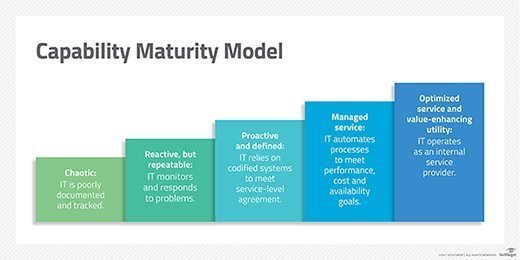
WavebreakmediaMicro - Fotolia
IT service delivery model uses BPM to translate ops to biz
A business process management structure for IT service delivery can bridge the gap between IT and the rest of the business, allowing IT leaders to sit at the table for important decisions.
Strategic IT service delivery models are new on the scene.
In many organizations, the IT department was an evolutionary outgrowth of increased dependence on technology. This meant IT itself was often organized around technologies, not business processes or salable products. The resulting IT silos, marred by intra-departmental finger-pointing and information hoarding, create inefficient operations, poor IT service delivery and slow responsiveness to new service requests.
Companies require speed to become successful digital businesses that blend the online and offline worlds. Consequently, the enterprise IT service delivery model is under pressure to show value and responsiveness without exploding the budget.
Service-oriented IT and associated process and management methodologies, such as COBIT, IT service management and ITIL and Microsoft Operations Framework, can rectify the ad hoc chaos. While the goal of disciplined, consistent delivery of IT services is laudable, those models inadvertently created burdensome processes with endless bureaucracy at the expense of nimble service delivery. The commercial success of cloud infrastructure and as a service offerings inspired IT organizations to again seek better ways to run IT as a service (ITaaS): applying a business process management (BPM) structure while eliminating baggage.
Originally developed for manufacturing, logistics, finance and sales, BPM is also useful for IT. Since BPM focuses on outcomes, not tasks, it helps IT organizations align services, investments and customer-facing processes with business requirements and strategies. Today's breadth and depth of IT operational data, log analysis tools and big data analytics provide IT leaders with fact-based insights into business use of services and resources, service reliability, security, costs and the utilization of existing IT assets. This information is vital to measure how IT meets business needs, while optimizing IT efficiency and spending.
Applying BPM as an IT service delivery model
BPM provides a structured methodology for delivering IT as a service, but before designing processes, you must know what services the company and its various business units need and the value placed on each. For IT, BPM can seem strange -- it borrows elements from product marketing: delivering a product or service that the customer wants in a repeatable, cost-efficient way, while rapidly responding to new feature requests.
To achieve BPM-style IT service delivery, the business leaders need to change how they perceive the IT department. IT needs a proverbial seat at the table when decisions are made on business strategies and product and project goals. IT staff must stop speaking in technical jargon and translate the department's technical capabilities into useful information services. Aside from improving communications, IT organizations can facilitate implementing ITaaS by setting up liaisons -- IT generalists skilled at translating technological details into business capabilities -- with dual reporting relationships to IT and the respective business unit.
With organizational changes in place, IT can set about the task of bringing rigor and governance with this BPM-based IT service delivery model.
The stages of maturity in a business

The standard BPM taxonomy uses a Capability Maturity Model that describes five stages of organizational maturity with specific decisions and steps to move from delivering IT as a hodgepodge of individual technologies to managing it as a value-producing service.
- Chaotic: The status quo in many organizations in which processes are undocumented, ad hoc and constantly changing with little notice. In this state, IT is considered an impediment to the business and shadow IT flourishes. First step: document and monitor.
- Reactive, but repeatable: Most IT processes have some documentation that provides consistency, but IT is still reactive, monitoring and responding to problems but with no guaranteed service levels. Next step: document task-level details and automate.
- Proactive and defined: Process definition is complete and published as a standard business process that can be automated. Systems are established to measure service availability, analyze usage trends and predict problems. Next step: fully automate and measure tasks and services.
- Managed service: Automated processes enable the IT organization to deliver defined services meeting business requirements with guaranteed performance and availability levels, transparent pricing and published metrics. Climbing the final BPM rung requires feeding back metrics to optimize services and infrastructure.
- Optimized service and value-enhancing utility: IT service delivery is fully automated with usage, performance and reliability data used to optimize processes and infrastructure usage and lower costs. Services may be delivered as subscriptions with consumption-based pricing similar to commercial infrastructure as a service and software as a service products.
Implementing BPM requires both executive leadership and business buy-in since the IT services must be clearly aligned with business goals, needs and strategies. This requires a mix of project management, cultural adjustment and technological improvement that includes the following tasks:
- Building the business case for BPM using return on investment (ROI) data from the combination of more valuable IT services and greater operational efficiency.
- Establish a governance structure that spans IT and its customers, i.e., business units and core functions such as human resources and finance.
- Identify and acquire necessary new technology required to virtualize, automate, measure and analyze service delivery.
- Manage cultural and organizational change as IT transitions from focusing on operations to business services.
- Market and communicate the benefits of BPM and ITaaS to customers and business executives.
Some may question the implicit assumption that running IT as a service and using BPM to improve its service delivery model with structured, repeatable processes is the best way to run IT. However, that is how successful businesses selling infrastructure, software and other managed IT services work -- and it's the way increasing numbers of company executives expect IT to work. More than half of business executives see BPM as either significant or imperative to their organization, with 41% seeing positive ROI from BPM investments within a year due to better coordination between individuals, greater organizational agility and reduced cycle times, according to a recent survey by the Association for Information and Image Management. An important motivation for adopting BPM is to improve regulatory compliance and security, which is a proven risk of sloppy IT operations.
BPM can improve IT agility and the likelihood of successfully achieving digital business goals, according to a Gartner study. The study also showed that 75% of organizations are still in the middle of BPM process definition, standardization and automation. If your business ranks among that 25% with IT organizations that have a good handle on critical processes and aligned services with business needs, your company is at an advantage over the majority of its competitors.







